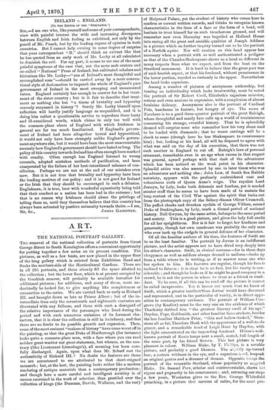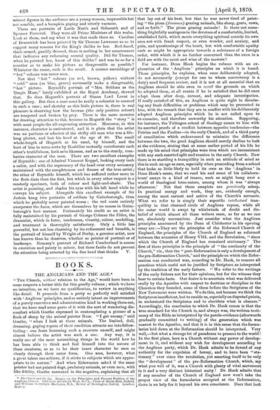ART.
THE NATIONAL PORTRAIT GALLERY.
THE removal of the national collection of portraits from Great George Street to South Kensington offers a convenient opportunity for putting together a few notes on its present condition. The pictures, as well as a few busts, are now placed in the upper floor of the long gallery which is entered from Exhibition Road and flanks the southern side of the Horticultural Gardens. There are in all 295 portraits, and these already fill the space allotted to the collection ; but the lower floor, which is at present occupied by the Goodrich armour, will probably be available hereafter for additional pictures ; for additions, and many of them, MUSD un- doubtedly be looked for, to give anything like completeness or connection to the series. We are carried back as early as Richard III. and brought down as late as Prince Albert ; but of the in- termediate time only the seventeenth and eighteenth centuries are illustrated with any fullness, and these with such a disregard of the relative importance of the personages who lived during the period and with such numerous omissions of its foremost cha- racters, that it is clear the collection is still in its infancy, and that there are no limits to its possible growth and expansion. Then, some of the most eminent "makers of history" have come worst off in the painting, so that the great Duke of Marlborough (for instance) looks quite a common-place man, with a face where you can read neither great warrior nor great statesman, but whence, on the con- trary (like Lieutenant Lismahago's), all meaning has been care- fully discharged. Again, upon what does Mr. Scharf rest the authenticity of Richard III.? No doubt the features are those we are accustomed to see attributed to that short-reigned monarch ; but, at the best, the painting looks rather like a modern rendering of antique materials than a contemporary production ; and though here a more careful and intelligent scrutiny is of course exercised in the work of selection than presided over the collection of kings (the Duncans, Davids, Wallaces, and the rest) of Holyrood Palace, yet the student of history who comes here to confirm or correct written records, and thinks to recognize known characteristics in the lines of a face or the form of a head, will hesitate to trust himself far on such treacherous ground, and will remember now even Macaulay was beguiled at Holland House into seeing all the great and amiable qualities of Joseph Addison in a picture which on further inquiry turned out to be the portrait of a Norfolk squire. Nor will caution on this head appear less necessary when a portrait with so well authenticated a pedigree as that of the Chandos Shakespeare shows us a head so different in many respects from what we expect, and from the bust on the Stratford monument. It is hard to believe that the great poet was of such boorish aspect, or that his forehead, without prominence in the lower portion, receded so curiously in the upper. Nevertheless the head looks capacious.
Among a number of pictures of anonymous authorship, but bearing an individuality which looks trustworthy, must be noted the portrait of Sir Robert Cecil, Elizabeth's sagacious minister, serious and even anxious in expression, with a complexion of almost feminine delicacy. Anonymous also is the portrait of Cardinal Pole, handsome in feature, but hungry of eye. The name of Zucchero is to a good three-quarter portrait of the great Raleigh, whose thoughtful and manly face calls up a world of reminiscences concerning his strange, eventful history. That he is splendidly dressed will surprise none who remember how his very shoes used to be loaded with diamonds ; that he wears earrings will be a shock to some (though here he has Shakespeare to countenance him) ; but, looking at his head, all will be disposed to agree with what was said on the day of his execution, that there was not such another in England to cut off. Raleigh's love of personal ornament, remarkable even in an age when excess in that respect was general, agreed perhaps with that dash of the adventurer which has been noticed as the weak point in his character. Splendid attire was also assumed by one in later times who was an adventurer and nothing else ; John Law, of South Sea Bubble notoriety, appears with the profusely embroidered coat and voluminous curls of Queen Anne's reign. The royalist Lord Jermyn, by Lely, looks both debonair and fearless, yet it needed stouter stuff than he seems to have been made of to sustain the long contest of the Civil War against the spirit that looks out from the photograph copy of the Sidney-Sussex Oliver Cromwell. The puffed cheeks and drunken eyelids of George Villiers, second Duke of Buckingham, by Lely, mark a dismal period of national history. Nell Gwynn, by the same artist, belongs to the same period and society. This is a good picture, and gives the lady full credit for all her sprightliness. Nor is it fair to forget her kindness and generosity, though her own coachman was probably the only man who ever took up the cudgels in general defence of her character.
Of all the familiar authors of his time, the features of Swift are to us the least familiar. The portrait by Jervas is an indifferent picture, and the artist appears not to have dived very deeply into his sitter's character. Swift, in clerical costume—for in those days clergymen as well as soldiers always dressed in uniform—looks up from a table where he is writing, as if to answer some one who has spoken to him. His features are regular, though his face is inclined to fatness ; it is clear he is no fool, but his vanity is con- siderable; and though he looks as if he might be good company in a crowd, he is not the person in whom to trust as a friend or confi- dant. To be sure, if all this can be read off the picture it cannot be called inexpressive. Yet it leaves out much that we know of Swift, which a greater intellect•than Jervas' would have discerned and represented, and in the particular of vanity, is in direct oppo- sition to contemporary evidence. The portrait of William Con- greve (by Kneller) must be the very one on the evidence of which Thackeray dubbed him "the greatest literary swell of his age."
Dryden, Pope, Goldsmith, and other familiar faces are here, besides the less familiar Matthew Prior, "thin and hollow-looked," Shen- stone all as fat, Theodore Hook with the appearance of a well-to-do grocer, and a remarkable head of Leigh Hunt by Haydon, with the light concentrated on the impending forehead. Hilton's well- known portrait of Keats hangs next a small, seated, full-length of the same poet, by his friend Severn. This last picture is very pleasant in colour. William Blake, by T. Phillips, is a notable picture, and probably a good likeness. The slig Idly up-turned face, a certain wildness in the eye, and a capacious hod, bespeak an original genius and a dreamer of dreams. Opposite b nags the portrait of the venerable Stothard, whose popularity so aug,tred Blake. Dr. Samuel Parr, scholar and controversialist, shows his vigour and pugnacity in his countenance ; and, retracing our steps a few years, Woolaston gives us the Rev. George Whitefield preaching, in a picture that savours of satire, for the most pro- minent figures in the audience are a young woman, impressible but not sensible, and a bumpkin gaping and utterly vacuous.
There are portraits of Lords North and Sidmouth and of Spencer Perceval. They were all Prime Ministers of this realm. Look at them, and say what it was that made them so. Caroline of Brunswick has been painted by Sir Thomas Lawrence so as to suggest many reasons for the King's dislike to her. Red-faced, thick-armed, gaudily dressed, there is nothing in her countenance that indicates any redeeming mental quality. Did Sir Thomas, when he painted her, know of this dislike ? and was he so far a courtier as to make his picture as disagreeable as possible? Whatever the cause, such is the result. A coarser assemblage of " hot " colours was never seen.
Not that " hot " colours (as rel, brown, yellow) without " cold " ones (as blue, green) necessarily make a disagreeable, " hot " picture. Reynold's portrait of "Mrs. Siddons as the Tragic Muse," lately exhibited at the Royal Academy, showed that. So does Hogarth's portrait of Simon Lord Lovat in this gallery. But then a man must be really a colourist to succeed in such a case ; and sketchy as this little picture is, there is real pleasure is observing how the browns (the only positive colour) are tempered and broken by grey. There is the more occasion for drawing attention to this, because in Hogarth the " story " is with most people the all-engrossing attraction. Moreover, in this instance, character is caricatured, and it is plain that the artist was no partizan or admirer of the shifty old man who was a life- long plotter, and lost his head at the age of 80. The small whole-length of Hogarth at his easel, by himself, and the bust of him in terra-cotta by Roubiliac mutually corroborate each other's truthfulness, both as to likeness, and as to the sturdy, com- bative character of the man. There are two excellent examples of Reynolds ; one of Admiral Viscount Keppel, looking every inch a sailor, and with the supremacy of the head over every accessory maintained with the completeness and finesse of the true artist ; the other of Reynolds himself, which has suffered rather more in the flesh-tints than the first, but which in every other respect is a masterly specimen, both of colour and light-and-shade. The artist is painting, and shades his eyes with his left hand while he surveys his subject. Alongside this excellent example of Sir Joshua hang two portraits of soldiers by Gainsborough, than which he probably never painted worse ; the red coats entirely overpower the faces, which are themselves by no means in Gains- borough's best manner. Fortunately his credit as an artist is fully maintained by his portrait of George Colman the Elder, the dramatist, which in force, tenderness, vivacity, colour, modelling, and treatment is thoroughly satisfactory. Only a little less powerful, but not less charming by its refinement and breadth, is the portrait of himself by Wright of Derby, a genuine artist, now less known than he deserves, whether as painter of portrait or of landscape. Romney's portrait of Richard Cumberland is coarse in execution and painty in colour, but these faults do not prevent the attention being arrested by the fine head that thinks. V.



































 Previous page
Previous page